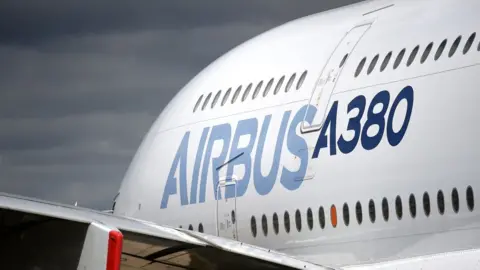Superjumbo jet future secured by Emirates order
 PA
PAThe Emirates airline has announced an order for up to 36 Airbus A380s.
The $16bn (£11.5bn) deal amounts to a reprieve for the A380 after Airbus threatened to stop making the jet if it could not come to a deal with Emirates.
Emirates is the only airline to have put the A380 at the heart of its operations and had been expected to place an order for more of the jets at the Dubai Airshow last November.
However, it then ordered 40 Boeing 787 Dreamliners instead.
Emirates said it had now made a firm order for 20 of the A380, the world's largest passenger airliner, with options to buy a further 16. Deliveries are scheduled to begin in 2020.
Emirates is already the largest customer for the plane, with 101 currently flying and 41 more firm orders previously placed.
On Monday, Airbus sales director John Leahy said the company would have to halt the A380 programme if Emirates did not place another order.

Analysis: Theo Leggett, business correspondent
 Getty Images
Getty ImagesThis is a vital order for Airbus, which has been struggling to get airlines to buy its troubled superjumbo. It has been forced to slow production right down, from 27 aircraft annually a couple of years ago to 12 this year. It expected to deliver just eight in 2019.
Emirates is far and away the biggest customer for the A380. Without its backing, Airbus would eventually have had to close down the production line in Toulouse altogether. Now the programme has the life support it needs.
Airbus says today's order underscores its commitment to produce the A380 for at least another 10 years. By that time, growth in the aviation market may have recreated a business case for it.
The A380 was designed to carry large numbers of people between heavily congested hub airports, where take-off and landing slots are at a premium. In recent years, it hasn't been needed, because airlines have focused on using smaller, more fuel-efficient aircraft to carry passengers, often on direct routes between secondary airports.
But if the market continues to grow rapidly, airport congestion may well become a serious issue again, particularly in Asia. At that point the A380 could come into its own.

The A380 project was first conceived in the early 1990s as an eventual successor to the Boeing 747, with development work beginning in earnest in 1993.
The plane has twin decks of seats, and is designed to incorporate amenities such as bars, lounges, beauty salons and duty-free shops, according to customer specification.
Before this latest deal, there had been a total of 317 orders for the A380 since its launch in 2007.
It made its debut commercial flight in October 2007 with Singapore Airlines flying from Singapore to Sydney.
Qantas took orders of the plane in 2008, flying the route between Melbourne and Los Angeles. Air France and Lufthansa have also flown the Airbus A380, but its largest customer over the years has been Emirates.